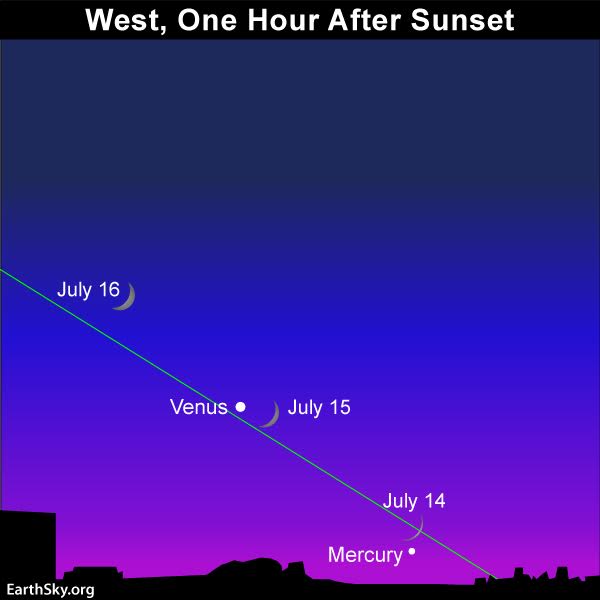Suzanne Murphy in Wisconsin caught the innermost planet, Mercury, below the moon on Saturday evening, July 14, 2018.
Ken Christison caught the pair from North Carolina on July 14. From across North America, Mercury appeared on Saturday below the moon, but it was a challenge to see with the eye.

The waxing crescent moon is sweeping by the planets Mercury and Venus this weekend. Be sure to look for Venus near the moon Sunday evening! Spectacular sight! Read more.
The little “star” next to the crescent moon in this photo is the planet Mercury. Venus is the bright object near the top of the photo, which was taken July 14, 2018, by Helio Vital in Rio de Janeiro, Brazil. He wrote: “The 4.7 percent illuminated crescent moon and Venus (2.4 times dimmer than the moon) became very easy targets about 20 minutes after sunset, while Mercury (200 times fainter than the moon) took some extra 20 minutes to appear in the twilight sky.” Nikon Coolpix P900. Thanks, Helio!
From South America, Mercury was oriented above the moon. It set longer after the sun and was easier to spot from that part of the world. Photo taken July 14 by Patricio Leon in Santiago, Chile.
Bottom line: Photos from the EarthSky community of the waxing crescent moon near the planet Mercury on July 14, 2018.
from EarthSky https://ift.tt/2NRGofv
Suzanne Murphy in Wisconsin caught the innermost planet, Mercury, below the moon on Saturday evening, July 14, 2018.
Ken Christison caught the pair from North Carolina on July 14. From across North America, Mercury appeared on Saturday below the moon, but it was a challenge to see with the eye.

The waxing crescent moon is sweeping by the planets Mercury and Venus this weekend. Be sure to look for Venus near the moon Sunday evening! Spectacular sight! Read more.
The little “star” next to the crescent moon in this photo is the planet Mercury. Venus is the bright object near the top of the photo, which was taken July 14, 2018, by Helio Vital in Rio de Janeiro, Brazil. He wrote: “The 4.7 percent illuminated crescent moon and Venus (2.4 times dimmer than the moon) became very easy targets about 20 minutes after sunset, while Mercury (200 times fainter than the moon) took some extra 20 minutes to appear in the twilight sky.” Nikon Coolpix P900. Thanks, Helio!
From South America, Mercury was oriented above the moon. It set longer after the sun and was easier to spot from that part of the world. Photo taken July 14 by Patricio Leon in Santiago, Chile.
Bottom line: Photos from the EarthSky community of the waxing crescent moon near the planet Mercury on July 14, 2018.
from EarthSky https://ift.tt/2NRGofv

Aucun commentaire:
Enregistrer un commentaire